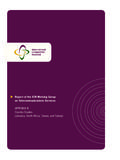Transcription of ICN AdvocacyWG CA Report - International …
1 1 Report on Assessment of ICN Members Requirements and Recommendations on Further ICN Work on Competition Advocacy Prepared by ICN Competition Advocacy Work Group Sub-Group 1: Review and Update Project Presented at the 8th Annual Conference of the ICN Zurich, June 2009 2 Table of Contents Executive 1. Organization of competition advocacy efforts by competition Types of CA efforts competition authorities are engaged Degree of influence of other authorities and institutions on the competition authority advocacy efforts. Political environment for competition advocacy.
2 7 Agency independence and autonomy in conducting C Impact of autonomy on advocacy activities ..8 Impact of the political environment on advocacy efforts ..9 Legal background of CA ..10 Legal authorization for CA activities ..10 Use of formal powers when engaging in advocacy efforts ..11 Agency resources dedicated to advocacy ..13 Measuring success of CA efforts by the competition authority ..15 Challenges in conducting CA activities ..17 2. Institutional dimension of CA with other government and non-government institutions an Means for promoting competition policy.
3 20 Policies advocated ..25 Consumer education ..27 Private rights of action CA aspects ..29 Examples of successes in CA with government and non-government institutions experience to share ..31 3. Sectoral directions of Sectors of economy targeted by CA Sector specific scope and goals of CA efforts ..37 Examples of successes in sector advocacy experience to share ..38 Mexico Retail trade in gasoline ..38 Norway Financial Services ..38 Russia Electric power supply ..39 US FTC Turkey Sector oriented means of competition advocacy ..40 Conclusions/recommendations on further ICN work on competition Member recommendations for further ICN work in the institutional dimension of CA.
4 42 Suggestions on sector oriented CA work ..44 ICN Members suggestions for use of ICN work products and directions of further CA related work ..45 Annex 1. Questionnaire ..54 Annex 2. List of ICN CA related work-products and data on their use by ICN Annex 3. Recommendations on Improving Competition Advocacy Toolkit ..68 3 Introduction The purpose of this Report1 is to (i) elaborate on ICN members experiences with competition advocacy ( CA ), (ii) summarize their suggestions for future ICN work in the area, (iii) assesses the extent to which existing ICN work product has been used by members, (iv) inform ICN members as they consider what, if any, additional work should be done on competition advocacy.
5 The Project is using the CA definition as provided in Advocacy and Competition Policy Report of 2002: Competition advocacy refers to those activities conducted by the competition authority related to the promotion of a competitive environment for economic activities by means of non-enforcement mechanisms, mainly through its relationships with other governmental entities and by increasing public awareness of the benefits of competition. For purposes of this project, the Report focuses on CA activities in institutional areas (for examples, advocating competition with government bodies2, sector regulators3, business community4, and special interest groups5, facilitating competition culture in society6, consumer education7 etc.)
6 And sectoral areas that are closely related to each other and enforcement practices. The institutional area provides for targeting CA efforts at specific institutions, both public and private, and/or social categories, as well as at organized special interest groups ( , consumer associations, small business associations or pressure groups etc.) that may either facilitate or hinder competition, depending on the character of a particular group. The sectoral area is characterized by CA focused on specific sectors in which competition law enforcement is limited or not possible due to market failures and/or government policies.
7 The working group collected responding agencies opinions on possible further ICN efforts in the field of CA through the use of a Questionnaire (please see Annex 1). The Questionnaire 1 This Report was prepared by: Edgar Carballo (Mexican FCC), Vladimir Kachalin (Russian FAS), Nancy Olson ( DOJ), Heidi Sada (Mexican FCC), Andrei Tzarikovsky (Russian FAS). 2 For example, Croatia is at the moment in the process of adopting new Competition Act, the efforts are mostly focused on government institutions, such as Ministry of Economy and Ministry of Justice, legislative bodies such as Parliament and judicial bodies, particularly on Commercial Court and Minor Offence Court.
8 3 For example, the Antitrust Division of the Department of Justice participates in proceedings, submits comments to, appears before, or consults on competition-related issues with many federal agencies. A major focus of the Division s competition advocacy with other federal agencies involves the submission of comments and intervention in federal regulatory agency proceedings in an effort to focus attention on competitive issues and to suggest adoption of the least anticompetitive and best designed forms of regulation where regulation is deemed necessary. 4 For example, in the United Kingdom, the OFT promotes competition policy to business through a combination of its market studies, and the substantial material it publishes on competition compliance.
9 Officials from the OFT senior management team and board often address specific sectors of the business community and organizations such as retail consortiums. 5 For example, in Poland the promotion of the competitive environment is also conducted by means of cooperation with organized special interest groups, consumer associations, small business associations or pressure groups etc. that may either facilitate or hinder competition, depending on character of a particular group. 6 For example, in Korea, the KFTC undertakes lectures and presentations for promotion and education on competition law: over the total 66 occasions between April and December of 2008, Chairman directly promoted KFTC policy and activities to business, academic and media circles, and moreover, the KFTC held education and counseling sessions for those engaged in the sectors where antitrust infringements tend to occur frequently 7 For example, the Jamaica Fair Trading Commission is targeting students at all levels.
10 They recently published a book on Competition for children under the age of 10, which is now being distributed throughout the country. The Commission apso conducs lectures at tertiary level institutions and teaching classes at secondary level institutions. 4 elicited information on the members recent competition advocacy efforts, the sectors in which the agency is most actively engaged in CA or CA efforts are required, the use of existing ICN CA work product by responding members, and their recommendations on possible further ICN projects. The conclusions and recommendations of the Report are based on the responses to the questionnaire provided by 32 ICN 8 Member agency responses from the following jurisdictions.
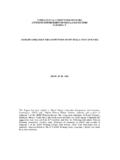
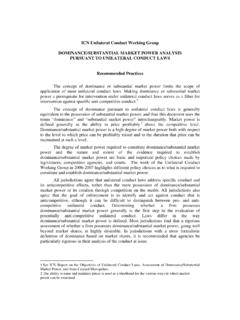


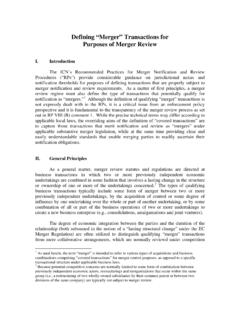


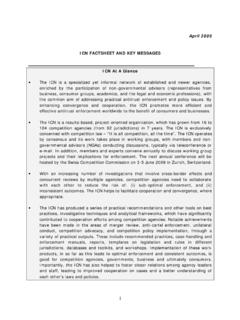
![[MERGER NOTIFICATION PROCEDURE TEMPLATE]](/cache/preview/4/4/e/2/5/9/d/c/thumb-44e259dc3896a9580aeac27f113f9044.jpg)


